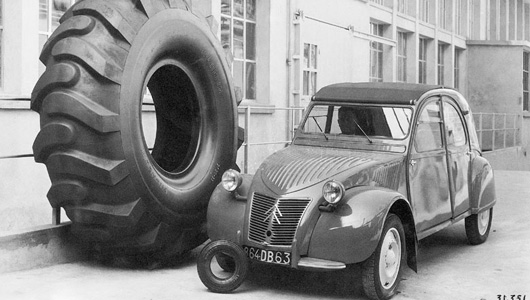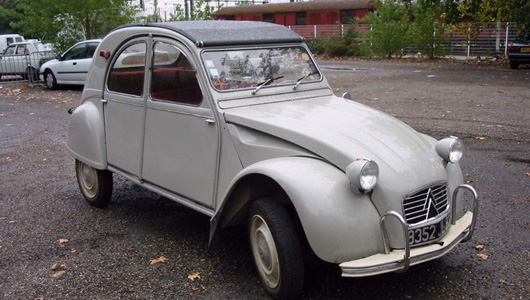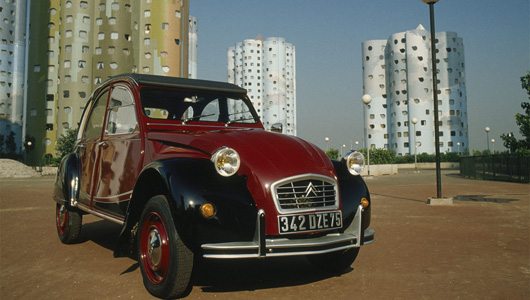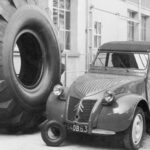The 2CV model is considered the “Ford Model T” of the French and it has also become a legend of the Citroen car company.
The 2CV is known as the “Deux Chevaux” in French, which translates to “2 horsepower” in English. It got its name from the car tax scale based on horsepower rating and cylinder capacity that was common in Europe in the early 20th century. The first 2CV made its official debut at the 1948 Paris Motor Show, marking the beginning of a production run that would span millions of cars. Within a short period of time, the 2CV became a common sight on roads all across Europe. Production of this type of car finally came to an end in 1990, over 40 years after its introduction.
2CV and its revolutionary design
To understand the history of the 2CV, we have to go back to the late 1930s. In 1936, Pierre-Jules Boulanger, the man behind the famous Traction Avant, started working on a car project called TPV (“Très Petite Voiture” – Very Small Car). He collaborated with top experts like Flaminio Bertoni and André Lefebvre. The first prototype was created in 1937.
Unfortunately, the outbreak of World War II interrupted the development of the car. The prototype was dismantled and scattered across France to prevent it from falling into German hands. During this time, Pierre-Jules Boulanger continued his research and made improvements. Testing resumed in 1946, and to keep the project a secret, Boulanger purchased a piece of land in La Ferté-Vidame in the western part of Paris, which is now Citroen’s test center.
Finally, the momentous day arrived. On October 7, 1948, the 2CV was unveiled at the Paris Motor Show, causing a major stir. Initial reactions were mixed, with the car’s design being considered shocking due to its departure from the familiar Traction Avant style. However, the most important thing was that the 2CV captured everyone’s attention. Despite skepticism from the press, the general public embraced the new car with enthusiasm. Orders poured in, and the factory struggled to keep up with demand. Some customers had to wait for years to get their hands on their dream car.
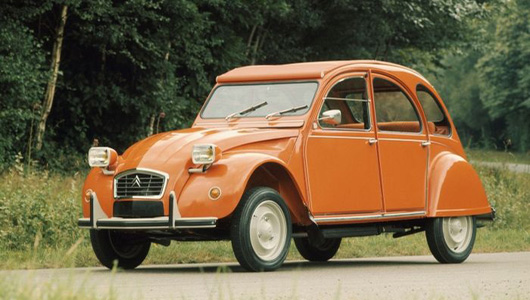
The most distinctive feature of the 2CV’s design is its symmetrical arrangement of doors. The front of the car is lively, with a hood made of wavy sheet metal and a radiator grille adorned with the inverted V logo in an oval frame. All parts of the body can be easily disassembled and reassembled thanks to cleverly arranged joints and screws. Weighing only 500kg, the car reaches a modest speed of 65km/h by today’s standards and has a fuel consumption of 4.5 liters per 100km.
With its various advantages, the 2CV turned out to be the small, practical, and affordable car that Pierre-Jules Boulanger had envisioned. Sadly, Boulanger passed away shortly after in 1950, without witnessing the greatest achievement of his life taking its first wobbly steps.
Changes
The 2CV underwent several changes in the 1950s. One significant development in 1951 was the launch of the 2CV utility version (model AU) for transporting goods. In 1954, Citroen increased the total engine capacity to 425cc. In December 1956, Citroen introduced the 2CV AZL model. With a large rectangular rear window and a fabric roof, the AZL was considered the high-end version of the 2CV range.
In 1960, the designers decided to give the 2CV a makeover for the first time, focusing primarily on the interior design. The hood also received a new look with five grooves and openings on both sides.
Another model of the 2CV was unveiled at the 1961 Paris Motor Show, the 2CV AZLP. With an actual power output of 13.5 horsepower at 4,000rpm, this powerful car reached a top speed of 85km/h and had a fuel consumption of 5.5 liters per 100km on long trips.
In 1964, the “Duck” underwent another transformation, this time with a revolutionary change: the doors were hinged at the front instead of the traditional rear-hinged design. With this improvement, the “Duck” was heading in the right direction.
The front end of the car underwent another redesign in 1966 to keep up with contemporary tastes. The radiator grille now consisted of three horizontal aluminum bars, while additional black plastic layers covered the front drum brakes. The 2CV was considered a people’s car, but above all else, it was a standout car for urban dwellers.
Special editions
The 2CV received a complete revamp for the 1974 Paris Motor Show, featuring a plastic radiator grille and rectangular headlights. The magical “Duck” still had surprises in store… In an effort to innovate while still catering to fans of the classic style, Citroen introduced a “Special” 2CV model in 1976 for enthusiasts of the traditional design. With round headlights, a minimalist interior, and an externally old-fashioned appearance, this model looked nearly identical to the first 2CV ever produced.
The “Charleston” model brought about a series of special editions of the 2CV in 1981. With details reminiscent of the 1930s, such as round van headlights and a deep black body, this car achieved immediate success. Shortly after its introduction, the model became a standard offering and was included in the company’s catalog starting from 1982.
The “Dolly” model was introduced in 1985, featuring a combination of two solid colors such as vanilla and gray, green and black, or red and gray. In 1986, the 2CV continued to maintain its position as a “car for the people” in France. The special edition “Cocorico,” with a Red-White-Blue exterior representing the French flag, vividly exemplified this position. The advertising slogan for this car was “This 2CV is really something special”.

The need for cars that could run in areas such as deserts led Citroen to develop the 2CV 4×4. Each axle was powered by two engines, one in the front and one in the rear.
With a sufficient load, the 2CV 4×4 could perform well on terrains with sand or slopes steeper than 40%. However, the rear-mounted engine limited the car’s payload. Although it was announced in March 1958, actual production of this type of car did not begin until 1960. By 1966, Citroen had produced 694 2CV 4×4 cars.
Source: PL&XH (translated from Vietnamese) (According to PL&XH/ Source: T?ng h?p)
Get to know the “duckling” CV2 from Citroen
“The 2CV car model is often compared to the “Ford Model T” of the French and it has also been considered as a true icon of French design and engineering. With its unique and distinctive appearance, the 2CV stands out on the road and captures the attention of all who see it. Known for its simplicity, durability, and affordability, the 2CV has become a beloved classic that continues to charm car enthusiasts and collectors around the world. It is a testament to the ingenuity and creativity of the French automotive industry, and a symbol of French cultural heritage. So, why settle for ordinary when you can experience the extraordinary with the 2CV?”






























